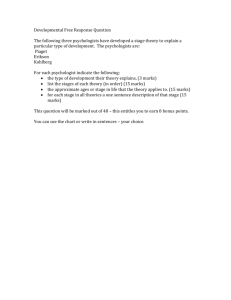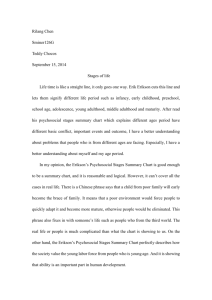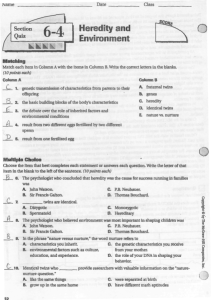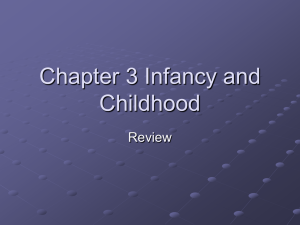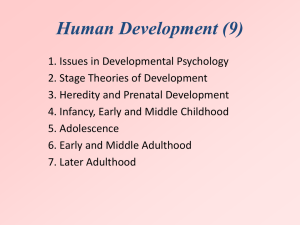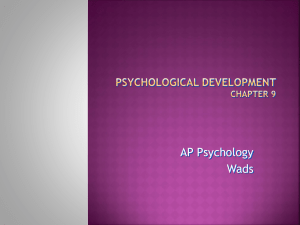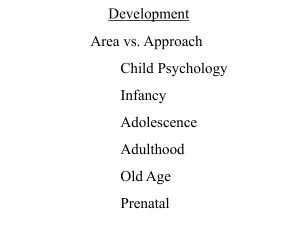CH. 9 Child Development Slides
advertisement
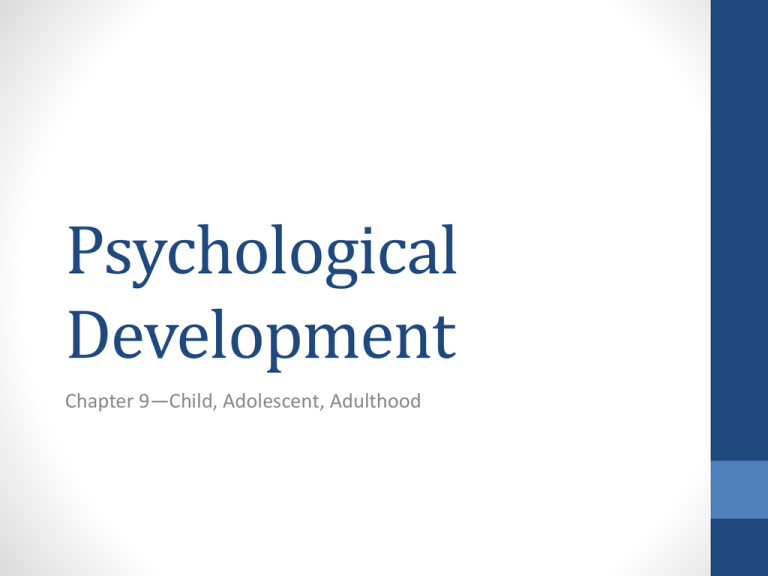
Psychological Development Chapter 9—Child, Adolescent, Adulthood Background Info: Developmental Psychology • Is the psychology of growth, change, and consistency through the life span. • It looks at how thinking, feeling, and behavior change from infancy, to adolescence, to adulthood. Background Info: Developmental Psychologist • Developmental Psychologist seek to discover “who we are”. • They focus on Nature vs. Nurture • Nature refers to the effects of heredity and nurture refers to the influence of the environment. Core Concept • Development is a process of growth, change, and consistency brought about by an interaction of heredity and and environment. • Heredity and environment are always intertwined in an inseparable relationship. • Development, then, is the story of nature-nurture interaction over a life span. The Nature-Nurture Interaction • Shakespeare first brought these terms together. • He grasped the idea that nature and nurture work in partnership rather than working as opposing forces. • Heredity (Nature) establishes your potential but experience (Nurture) determines how your potential will be realized. Twins • Identical Twins (Monozygotic): These twins develop from only one fertilized egg, that for unknown reasons divide into two separate eggs. • Identical twins have the same genes or heredity. • Fraternal Twins: (Dizyigotic): meaning twins develop from two different eggs fertilized by two different sperm. • These twins are no more alike in their genetic makeup (heredity) then any other siblings. Twin Studies • Since twins who were separated at birth are not so common, Psychologist have started to test their theories of naturenurture from studies comparing identical and fraternal twins who were reared together. • These studies have provided valuable info. on: the genetics of mental and behavioral disorders (alcoholism, Schizophrenia, depression) Adoption Studies • If you adopted a baby, would he/she grow up to resemble you more than the biological parents? • Psychologist answer these questions by comparing the characteristics of adopted children with those of their biological and adoptive family members. • Their method for separating the effects of heredity and environment are: • Similarities with the biological family point to nature, while similarities with the adoptive family suggest the influence of nurture. • This research has helped in understanding temperament, intelligence, sexual orientation. Gradual vs. Abrupt Change • Does development follow a set, predictable pattern? Or, is it random and different for each individual? Continuity View • In this view, change is gradual. • Children become more skillful in thinking, talking, or acting in much the same way that they become taller with age: a gradual developmental pattern that increases with age. • Do complex mental processes like thought or language follow the same pattern? Discontinuity View • Psychologist who take this opposing view, see development as more “abrupt”– a succession of changes that produce different behaviors in different age specific life periods. • Developmental Stages: • periods of life initiated by distinct transitions in physical or psychological functioning. • “Terrible Twos” • Psychologist find that people go through the same stages in the same order—but not necessarily a the same rate. Psychology in your Life: Psychological Traits in your Genes • Clinical Disorders associated with genetics: • Huntington’s disease: a rare problem that causes aggressive behavior and mental deterioration beginning in midlife. • Depression: Roots in genetics—not always. • Schizophrenia/Anxiety Infancy Development • People used to think newborns began life as a “blank slate” with essentially no abilities. However, psychologist now know, that is far from the truth. • Core Concept: Newborns have innate abilities for finding nourishment, interacting with others, and avoiding harmful situations. Infancy Development Stages • Three important developmental stages: • 1. Prenatal Period • 2. Neonatal Period • 3. Infancy Prenatal Period • Prenatal Period spans the 9 months of pregnancy from conception—birth. • Stages: • After conception, the fertilized egg (zygote) begins to grow through cell division. (from 1 cell-150) • Then the zygote implants itself in the lining of the uterus—about 10 days after conception. • At this point, the egg, is now an embryo. Prenatal Period- Embryonic Phase • During this phase, the genetic plan determines how all the organs will begin to develop and form. • The cells begin to specialize as components of particular organs— differentiation. • The embryo’s cells form distinct layers: • Outer Layer= nervous system/skin • Middle Layer= muscles, bones, blood vessels, internal organs • Inner Layer- digestive system, lungs, and glands • By The end of the first month, the initial 1 cell zygote has developed into an embryo with millions of specialized cells. Prenatal Period • The first “behavior” of an embryo is a heartbeat. • The heartbeat appears when the embryo is about 3 weeks old and one-sixth of an inch long. • A few weeks later, the embryo makes reflexive responses to stimulation. • These behaviors occur long before the brain has developed to a point where it can direct behaviors. • After the 8th week, the embryo is now a fetus. Teratogens: Prenatal Toxins • Specialist used to think that the womb protected the developing organism from nearly all environmental assaults, but now we know better. • The placenta screens out some potentially dangerous substances, many can still pass through. • These toxic substances are teratogens. (HIV/AIDS) • The effects vary from slight to devastating. • Fetal Alcohol Syndrome Fetal Alcohol Syndrome http://www.hrmvideo.com/catalog/understanding-fetal-alcoholsyndrome Prenatal Development of the Brain • The brain grows new neurons at the amazing rate of up to 250,000 per minute. • All originate from a proliferation of cells at the top of the embryo’s hollow neural tube. • These furiously multiplying cells eventually become the brain. Neonatal Period • Birth—1 Month Old • Neonates are capable of responding to stimulation from all their senses. • Ex: newborn babies will turn their heads towards anything that stroke their cheek and begin to suck it. • As early as 12 hours after birth, neonates show distinct signs of pleasure at the taste of sugar water or vanilla. Neonatal Period (Vision) • Minutes after their birth, their eyes scan their surroundings. • Their vision isn’t perfect, babies tend to be born nearsighted. • At birth, the retina, visual pathways, and the occipital cortex are not fully developed. But, these immature systems develop very rapidly and the baby’s visual abilities soon become quite effective. Vision in Infants • Early on, infants can perceive large objects that display a great deal of contrast. • By 1 month, a child can detect contours of a head at close distances • At 7 weeks—the baby can scan features of the caregivers face. As the caregiver speaks, the baby can make eye contact. Newborn Child Abilities • After a month, babies are capable of differentiating colors. • 3 months—the baby can perceive depth • They also have the ability to “count” objects • They know the difference btw 2 dolls and 3 dolls • They also have strong auditory preferences. • Prefer the female voice • Born with behavioral reflexes that provide a biological platform for later development. • Ex: Postural Reflex/ Grasping Reflex Infancy and Childhood • This period last till the baby is 18 months old. • A period of rapid, genetically programmed growth and “instinctive” reflexes. • The brain and its circuits are not fully developed at birth, but during this period, the axons and dendrites branch out and connect—starting to form the brain. Infancy and Childhood • What is synaptic prunning? Learning in Development • Classical Conditioning: • Experiment: • Social Abilities: Attachment • Social development begins with the establishment of a close, emotional, relationship btw a child and a parent figure. • This relationship is important b/c it lays the foundation for future relationships. • Attachment behaviors appear to occur “instinctively”. • Imprinting: Attachment • Although humans apparently have an inborn need for attachment, there is no guarantee that parents will always respond to this need. • What can babies do to increase the chances of getting the contact that they want? • Babies can emit signals—smiling, crying. Anything to promote a responsive behavior. • Infants will form an attachment to anyone who consistently and appropriately responds to their signal. Mary Ainsworth—Stranger Situation • http://www.youtube.com/watch?v=DH1m_ZMO7GU Strange Situation • Ainsworth found that the children’s responses fell into 2 main categories: • Secure v. Insecure • Secure Children feel: • Close to their mothers, safe, and more willing to explore, confident they could cry out for help and they will be comforted. • Insecure: • Reacted with anxiety/avoidance. Unconcerned about being separated. • Attachment problems are good predictors of later problems with social relationships. Contact Comfort • Evolutionary Perspective- attachment safeguards an infants survival by assuring the support and protection it requires. Through natural selection, individuals with genetic tendencies to “attach” will survive, thrive, and pass on those tendencies to their own offspring. Cupboard Theory • Infants become attached to those who provide the “cupboard theory” containing the food supply. • This theory has been popular for those who support “nursing” because they believe it supports the parent-child bond. • Freud convinced many physicians and parents that young infants and children were so mentally undeveloped that the only thing important thing in there life was nursing or a bottle. He believed they weren’t capable of relationships yet. Harry and Margaret Harlow Experiment • Harlow’s placed orphaned baby monkeys in cages where they had access to two artificial surrogate mothers. • One was a simple wire figure that provided milk, but little else. • The other was a cloth covered monkey that provided no milk but offered an abundant stimulation from its terry cloth cover. • Confirming their expectations, the Harlows’ observed that the monkeys spend many hours nestled close to the cloth monkey and little time with the wire monkey. • http://www.youtube.com/watch?v=vbEdNJ-e-Yc Contact Comfort • Human infants need contact too. • If they lack a close, loving relationship in infancy it can effect physical growth. • Observations done of children from emotionally detached or hostile family environments have children who suffer from slower growth and bone development. • They may grow again if removed from the poor environment, but their growth can be stunted again if they are returned = Social Darwfinism. • Failure to Thrive: Maturation and Physical Abilities • Maturation- the unfolding process of genetically programmed growth and development over time. • Heredity and environment interact here again. • Example: Maturation and Physical Abilities • Physical growth in humans has always been viewed as a continuous process whose rate changes with age, slowing over time after a rapid start in the early years. • However, research has shown that growth in infants’ bodies has occurred in “bursts”—saltation (leap). Cognitive Development • Infants and children face especially important developmental tasks in the areas of cognition and social relationships--tasks that lay a foundation for further growth in adolescence and adulthood Piaget’s Theory • Children of different ages think differently • Changes in cognitive development proceed in distinct stages (discontinuous) • His approach is known as the cognitivedevelopmental approach • The driving forces behind development from one stage to the next is maturation Maturation in Piaget’s Theory • Piaget portrayed maturation as an active process • Children seek out information and stimulation in the environment that matches the maturity of their thinking Piagetian Schemas Schemas Assimilation Occurs when new information is altered to fit an existing scheme Accommodation Entails changing the scheme to adapt to the new information Schemas, Accommodation, Assimilation • Define and give examples. • For Piaget, Cognitive development results from continual interweaving of assimilation and accommodation. Through these 2 processes, the individual’s behavior becomes less dependent on concrete reality and more reliant on internal thought. Piaget’s Stages Piaget’s Stages of Development • http://www.youtube.com/watch?v=TRF27F2bn-A Limitations of Piaget’s Theory The stage of formal operations has been the most critiqued • Individual differences • Inconsistent usage • Differences as the result of schooling • Cultural differences • Varies according to cognitive requirements Social and Emotional Development • For a child to grow beyond Piaget’s idea of “egocentrism” a child must develop a “theory of mind”. • This consists of an awareness that others may have beliefs, desires, and emotions different from one’s own and that these mental states underline their behavior. • Social and emotional development relies heavily on ones temperament– our innate disposition. Temperament • An individual’s inherited, “wired in” pattern of personality and behavior. • Jerome Kagan Study: • Although basic temperament can be recognized at birth, they are not written in stone. • Experience and parenting styles can modify the way temperament expresses itself. • Example: • Lev Vygotsky: Social Cognitive Development • Social interaction plays a basic and key role in the development of cognition. • ZPD: Socialization • Life long process of shaping an individual’s behavioral patterns, values, standards, skills, attitudes, and motives to conform to those regarded as desirable in a particular society. • We first learn these things from our parents. Parenting Styles and Their Effects • Psychologist have found 4 distinct parenting styles across the world. • • • • 1. Authoritarian 2. Authoritative 3. Permissive 4. Uninvolved (Neglectful) Authoritative • High Expectations for children combined with high standards. • But, the child is treated with warmth, respect, and is allowed to share input and communicate with the parents. • They try to help their children grow as individuals by making their own decisions and learning from mistakes. • Children of authoritative parents • • • • Independent Creative Self-assured Socially skilled Authoritarian • “Dictators” • High in demand for conformity and obedience • They expect the child to to follow rules without discussion • Children of authoritarian parents • Dependent • Passive • Conforming Permissive • Parents make few or no demands on the child. • Wants to be the child’s “friend” • Loves and cares for the child, but allows them to make their own decision with little to no guidance • Children of permissive parents: • Irresponsible • Conforming • Immature Uninvolved/Neglectful • Neglectful/disengaged parents • Parents make few or low demands on the child • Low in warmth and affection, tend to lack interest in the child. • Children of neglectful/disengaged parents • Impulsive • Delinquent • Early involvement in sex and drugs Effects of Day Care • Over half of all mothers with children under the age of 3 are employed, and more children are cared for by paid providers than by relatives. • Research in this area sends mixed signals. • Most children thrive in daycare • Intellectually and socially • Some poor-quality daycare experiences influence children to be; • Aggressive, depressed, or maladjusted. • Laura Berk • *Daycare itself is neither good nor bad—it’s the QUALITY of care, whether given be a parent or paid provider that makes the difference* School and Leisure Influences • Children in the U.S. and other industrialized countries have much more free time than children elsewhere in the world. • American children spend less than one-half hour doing some type of chore, • The amount of “free time” has increased dramatically. • What has hard work proven? • How do children spend their extra time? Gender Differences in Socialization • In Play: • Boys are typically more aggressive and active. • Girls typically play more quietly and uniformed. • Groups: • Boys: Play in larger groups with a hierarchy, each boy competing for the “top spot” • Girls: Tend to play in smaller, organized groups. Gender Differences • Gender differences in play and groups is “innate” according to evolutionary psychologist. • But, not all gender differences are related to instinct, some gender differences are learned. • Like what? Erik Erikson • He was a recent immigrant to the U.S. • His new status caused him to become more aware of the choices and conflicts he was faced with. • He created a sequence of “psychosocial stages” • Defined by common problems that emerge throughout life: from infancy to old age. • Erikson believed when people face challenges and make decisions, these choices influence the growth of their personalities. Erikson’s Stages Erik Erikson • Erikson created 8 Stages • • • • • • • • 1. Trust vs. Mistrust 2. Autonomy vs. Self Doubt 3. Initiative vs. Guilt 4. Competence vs. Inferiority 5. Identity vs. Role Confusion 6. Intimacy vs. Isolation 7. Generativity vs. Stagnation 8. Ego-Integrity vs. Despair Critical Reflection on Erikson’s Theory • Lacks scientific basis • Does not adequately capture the problems faced by girls and women.
